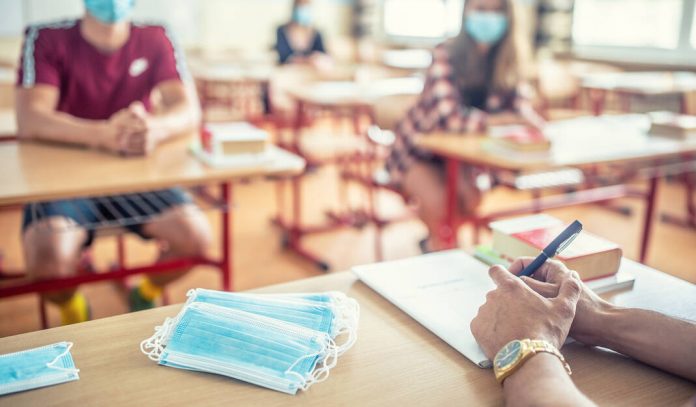
Dreamstime/TNS
When it comes to education, lawmakers are expanding their scope to monitor everything from books to a type of teaching called social-emotional learning.
When it comes to education, lawmakers are expanding their scope to monitor everything from books to a type of teaching called social-emotional learning. (Dreamstime/TNS)
By ELLA CERON
Bloomberg News
As lawmakers across the U.S. advance measures that prohibit teaching “critical race theory” and holding classroom discussions on gender and sexual identity, they’re also expanding their scope to monitor everything from books to teaching modalities that center on feelings.
Called social-emotional learning, this type of teaching builds on work that schools have done for years to foster collaborative and holistic environments for students. Critics say such educational methods should be left to parents and not teachers, and conservative-led challenges are cropping up at city and state levels.
>>What is social-emotional learning?
Social-emotional learning, or SEL, addresses children’s feelings and interpersonal skills as they learn. A variety of programs integrate SEL into the curriculum to help students build self-awareness and self-management, improve responsible decision-making and develop relationship skills. They include Second Step programs, which were developed by the nonprofit Committee for Children, as well as best practices established by the Collaborative for Academic, Social, and Emotional Learning, or CASEL. Advocates say social-emotional learning can help boost students’ confidence, teach them to better manage their emotions and prevent bullying. Some educators also use SEL to help children process their feelings in an effort to reduce rising suicide rates.
Resources for SEL programs are growing. Between November 2019 and April 2021, schools and districts increased SEL spending 45%, to $765 million, according to a report last year by Tyton Partners. The report also found that COVID-19 increased schools’ interest in SEL programs as a way of addressing problems that arose with remote learning.
>>What does social-emotional learning look like in practice?
It depends on the topic. Many guidelines suggest that educators ask students how they feel about difficult lessons, hold group activities and focus on communication skills. A guide published by CASEL suggests that teachers “establish shared classroom rules and expectations and consequences so that students can see the impact of their own actions and behaviors on outcomes” at the beginning of the school year. It recommends that teachers help children assess their strengths, weaknesses and frustrations with a given topic, like math or language arts.
The Second Step program asks children and educators to assess power and privilege in its anti-racism lessons. An excerpt from a textbook by Savvas Learning Company shared by The New York Times suggests that students “disagree respectfully” when establishing different ways to solve the same math problem.
“For students to excel academically, they need to feel engaged in the classroom, collaborate with their peers, and work through challenges,” said Aaliyah A. Samuel, the chief executive officer of CASEL, who has a doctorate in education. “If our nation prioritizes the academic growth of young people, we must also prioritize their social emotional learning.”
>>What are the benefits to social-emotional learning?
A 2017 study from the University of Massachusetts Medical School found that SEL helped pre-kindergarten students improve their executive function, better regulate their emotions and hone their social skills. The Tyton Partners report found that schools often use SEL frameworks to help close achievement gaps for minority and low-income students.
Now, over half of schools with majority Black and Latino students said they’re prioritizing students’ mental health and well-being. Schools are also more likely now than in 2019 to emphasize students’ social and emotional competence. And a 2019 report from the Aspen Institute found that high school students say they wish they had learned more social and emotional skills, which employers focus on in hiring.
>>Where is social-emotional learning being challenged?
Challenges are popping up across the country. The Canyons School District in Salt Lake County, Utah, suspended its Second Step program in September and said it would establish its own program to meet Utah State Board of Education requirements. The move followed pushback from the conservative group Parents of Patriots and from parents who claimed that schools were using social-emotional learning as a covert way of teaching critical race theory and sex education. In a press release, one Utah parent said any SEL program should be “politically and ideologically neutral.”
Other challenges to SEL have cropped up in Georgia, Indiana, Idaho, Minnesota and Texas. In Oklahoma, a state senator in February introduced a bill that would bar schools from using funds for SEL education. Similar legislation has been offered in Wisconsin. The Florida Department of Education on Monday said it rejected 41% of proposed math textbooks on the basis that they did not adhere to state standards or included prohibited topics, including critical race theory and SEL.
“It’s not about how you feel about the problem, or to introduce some of these other things,” Florida Gov. Ron DeSantis, a Republican, said in a press conference about SEL being used to teach math. “There’s a right answer and a wrong answer.”



